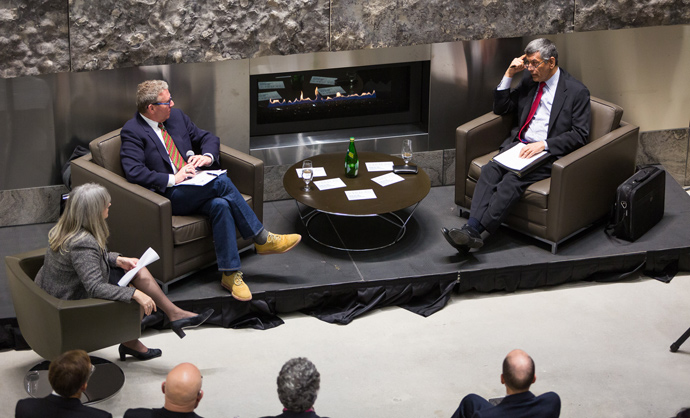
Should a government pay for its citizens to challenge the constitutionality of that government’s laws? How reliable is a government’s commitment to provide this kind of funding? More generally, is constitutional litigation the best way to protect Canadians’ constitutional rights?
On a cold November evening, the David Asper Centre for Constitutional Rights convened a fireside discussion of these questions in the Jackman Law Building. The discussion featured alumni Raj Anand, LLB 1978, a prominent constitutional litigator and bencher of the Law Society of Upper Canada, and David Asper, LLM 2007, the Centre’s founder and a successful criminal/constitutional litigator. (Most notably, Asper represented David Milgaard in overturning Milgaard’s wrongful conviction.)
- Watch the fireside chat online (YouTube)
Cheryl Milne, executive director of the Asper Centre, chaired the discussion, the focus of which was the Court Challenges Program (“CCP”). Created in 1978, the CCP funded legal challenges to laws offending equality and official language minority rights guaranteed under the Canadian constitution, including the Charter of Rights and Freedom. The program has funded more than 1,200 cases, but has also been cancelled, twice, by governments averse to funding challenges to their own laws. The current Liberal government plans to revive the CCP, and is undertaking consultations to this end.
The discussion was a study in contrasting viewpoints: Anand’s more conservative (reflecting his long experience as a member of the CCP’s Equality Rights Panel), and Asper’s more radical. Asper was adamant, for example, that the CCP’s strength comes from its independence. “It’s irresistible, in my view, that when you have an organization whose objective is to challenge the government, sooner or later the government will defund you—whatever the stripe.” Anand replied that perfect independence is impossible: “Ultimately, public money has to be carefully safeguarded and spent pursuant to government policies. So, like it or not, there are always public servants that have a direct and indirect impact on the program.”
Asper was unmoved, suggesting at one point that the CCP will always be “a sitting duck for government.”
While both lamented the CCP’s suspension by the Conservative government in 2006, they fastened upon different effects as being most significant. Anand noted the deleterious effect on s. 15 of the Charter (equality rights) jurisprudence because of fewer, and more poorly supported, cases being brought to trial. (“The kinds of arguments that were brought… became very weak.”) Asper characterized the CCP’s suspension as anti-constitutional: “It sent a signal to Canadians that we were somehow less willing to get into the risk of rights litigation. It was totally contrary to the spirit of the Charter.”
Milne then asked whether, given the CCP’s inherent limitations (in addition to independence issues, the CCP’s funding mandate—limited to equality and official language minority rights cases—has long been criticized as far too narrow), the CCP was the best way to support Charter litigation in Canada.
Asper dismissed this as a red herring. “Something is better than nothing,” he said, “but the discussion of CCP is a Band-Aid to a much more significant problem in the Canadian justice system.” Specifically addressing those in the audience watching live via webcast from Ottawa, he continued, “I believe that the courts, and the things that radiate inward from courts—judges, lawyers, systems, processes— are failing us. The court system itself is the biggest barrier to the adjudication of Charter rights.”
Anand was much more circumspect. “I think it’s a bit of a distraction to say that we have a bigger problem [i.e., access to justice] and therefore we shouldn’t look at this little problem [the CCP] and try to fix it. We have a rare opportunity here, and the question should be how we put this program back in place more durably and more effectively than the previous program.”
The ensuing discussion canvassed various alternatives to constitutional litigation, including less reliance on traditional adversarial processes (at the cost of establishing fewer binding precedents), a specialized constitutional court (diametrically opposed to the Supreme Court of Canada’s view on which tribunals can adjudicate Charter claims), and reformed civil procedure rules. Several members of the audience wondered at the viability of privately funded litigation supplanting the CCP, such as US-style charitable organizations seeking public interest standing to bring constitutional challenges.
No consensus emerged, and the discussion concluded with Asper underlining the ongoing—soon to be imminent—need to re-engage Canadians on the importance of Charter litigation following the CCP’s suspension in 2006: “We’ve probably come through an era of government where [the Charter] wasn’t so popular,” he said, “and that’s no longer the case.” Asper concluded by reminding the audience of what he sees as the broader context for the reformed CCP. Once again addressing the audience watching by webcast, he said, “Canadians are losing faith in our justice system as we continue to talk about doing all these things to fix it, and don’t fix it.”
By Christopher R. Graham / Photography by Salathiel Wesser
